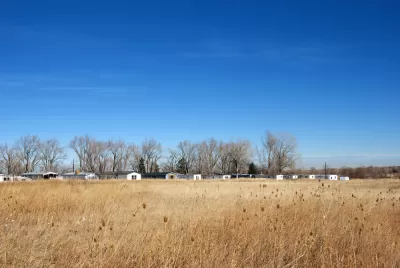Many housing and human services providers say their programs are underfunded as the housing crisis in rural parts of America grows.

A chronic economic decline over the last century and a strained housing supply are contributing to a growing housing crisis in rural America, where “one in four rural renters spends more than 50 percent of their income on housing.” Urban Institute researchers interviewed housing and human services providers in 12 rural counties to understand how well these programs are working in rural areas.
Anna Morgan and Corianne Payton Scally describe the results in Urban Wire. “Human services providers told us the rural families they served lacked affordable housing options and faced additional challenges because of low-paying jobs, poor quality of available housing, and high-cost burdens for renters.” Additionally, providers “shared concerns that federal income requirements for the programs they administer result in benefit cliffs for families, which limits their ability to maintain stable housing and meet basic needs.”
Proposed solutions include expanding federal housing programs in rural areas; partnering with local nonprofits to fill gaps in services, understand specific local needs, and share resources; and delivering services to people’s homes in areas where transportation is often a barrier to accessing resources.
Boosting support for housing programs is key to the overall social and economic wellbeing of rural communities, the researchers note.
FULL STORY: Housing and Human Services Programs Aren’t Meeting Rural Renters’ Needs

Alabama: Trump Terminates Settlements for Black Communities Harmed By Raw Sewage
Trump deemed the landmark civil rights agreement “illegal DEI and environmental justice policy.”

Planetizen Federal Action Tracker
A weekly monitor of how Trump’s orders and actions are impacting planners and planning in America.

The 120 Year Old Tiny Home Villages That Sheltered San Francisco’s Earthquake Refugees
More than a century ago, San Francisco mobilized to house thousands of residents displaced by the 1906 earthquake. Could their strategy offer a model for the present?

In Both Crashes and Crime, Public Transportation is Far Safer than Driving
Contrary to popular assumptions, public transportation has far lower crash and crime rates than automobile travel. For safer communities, improve and encourage transit travel.

Report: Zoning Reforms Should Complement Nashville’s Ambitious Transit Plan
Without reform, restrictive zoning codes will limit the impact of the city’s planned transit expansion and could exclude some of the residents who depend on transit the most.

Judge Orders Release of Frozen IRA, IIJA Funding
The decision is a victory for environmental groups who charged that freezing funds for critical infrastructure and disaster response programs caused “real and irreparable harm” to communities.
Urban Design for Planners 1: Software Tools
This six-course series explores essential urban design concepts using open source software and equips planners with the tools they need to participate fully in the urban design process.
Planning for Universal Design
Learn the tools for implementing Universal Design in planning regulations.
Clanton & Associates, Inc.
Jessamine County Fiscal Court
Institute for Housing and Urban Development Studies (IHS)
City of Grandview
Harvard GSD Executive Education
Toledo-Lucas County Plan Commissions
Salt Lake City
NYU Wagner Graduate School of Public Service





























